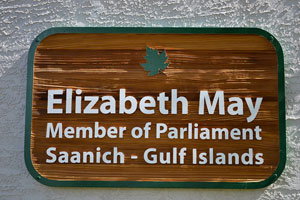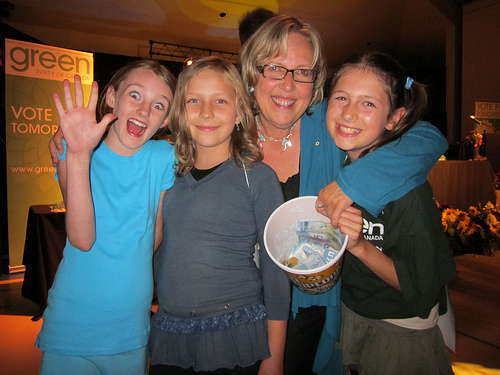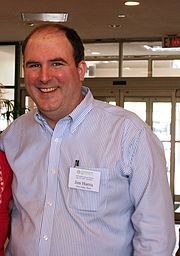Green Party in Canada continues to grow
Share
National Convention in British Columbia takes a look at why
By Mike Feinstein, member, GPUS International Committee
How did the Canadian Green Party win its first election to the House of Commons? Will it win more seats? What are the chances to overthrow Prime Minister Stephen Harper’s Conservative government? Can Canadian Greens learn from elected Greens around the world?
 These and other questions highlighted the recent Green Party of Canada bi-annual convention August 17-19, held six years after Elizabeth May was elected party leader and one year after she became the first elected Green to the House of Commons. Held in the British Columbia riding (district) that May was elected from (part of which is on Vancouver Island and part in the nearby Gulf Islands), the convention brought together almost 300 delegates and 150 others and was livestreamed to thousands more.
These and other questions highlighted the recent Green Party of Canada bi-annual convention August 17-19, held six years after Elizabeth May was elected party leader and one year after she became the first elected Green to the House of Commons. Held in the British Columbia riding (district) that May was elected from (part of which is on Vancouver Island and part in the nearby Gulf Islands), the convention brought together almost 300 delegates and 150 others and was livestreamed to thousands more.
The opening ceremony featured greetings from the mayors of the riding’s largest cities — Sidney and North Saanich, followed by a showing of the new film Surviving Progress, which presents the story of human advancement, revealing how civilizations are repeatedly destroyed by “progress traps” — alluring technologies that serve immediate needs, but ransom the future. May was joined by Ron Wright, whose book A Short History of Progress inspired the film, for a discussion of the film’s theme and a broad ranging question and answer session with convention attendees.
Campaign Lessons
Saturday morning began with a “What it Takes to Win—The Saanich-Gulf Islands Experience” workshop. Ken Wu, Campaign Communications Director, emphasized the need for a unifying issue for each campaign and using social media to generate interest and volunteers (the campaign had over 5,000 Facebook followers who lived in or nearby the riding).
 Marilyn Redivo told how she was originally skeptical of being involved, but after attending a volunteer meeting with her husband, she found she liked the experience and the candidate, and ultimately became the Campaign’s Volunteer Coordinator herself. The campaign had over 2,000 volunteers overall, including 700 who were actively involved in phone-banking, going door-to-door and standing on street corners with signs. What made the process work was the effort to make volunteers feel they were making valuable contributions.
Marilyn Redivo told how she was originally skeptical of being involved, but after attending a volunteer meeting with her husband, she found she liked the experience and the candidate, and ultimately became the Campaign’s Volunteer Coordinator herself. The campaign had over 2,000 volunteers overall, including 700 who were actively involved in phone-banking, going door-to-door and standing on street corners with signs. What made the process work was the effort to make volunteers feel they were making valuable contributions.
May and Campaign Manager Jonathan Dickie talked about the need for any candidate—and especially a Green seeking to break through the stereotype of ‘environment-only’—to be seen as involved in the community and well-rounded on the issues. In addition to May’s well-known reputation as an environmentalist, the campaign focused on issues of political accountability, and that May would be someone who would speak for the people, not at them.
Alliance-building
The convention would also hear from two other sitting members of parliament—former Liberal Party Leader Stephan Dion and independent Bruce Hyer, who left the New Democratic Party (NDP) in April 2012.
Dion promoted his plan for a limited version of proportional representation, called Proportional-Preferential-Personalized-Vote, or P3 , which would combine existing five single-seat ridings into larger ones of five members each, elected by single-transferable-vote.
The importance of electoral reform has long been recognized by Canadian Greens, as well the non-partisan organization FairVote Canada, which has documented Greens and others are consistently under-represented by Canada’s first-past-the-post electoral system. Recently, the theme has been taken up across more broadly, after Harper’s Conservative Party won a majority of seats in 2011 with less than 40 percent of the vote.
Hyer’s address, “How the Greens can Save Parliament” highlighted the important role May played in delaying passage and raising public awareness of the attacks on environmental and social justice legislation in the Conservative government’s omnibus budget bill. Hyer seconded many of May’s proposed amendments to the bill. Afterwards, he was asked whether he would join the Greens and replied that, since he had been elected while a member of the NDP, he owed the riding’s voters to stay independent for at least one year—with his answer leaving delegates hoping for a second Green MP soon after that.
Keynote Address/Fundraiser
Saturday night began with a heartfelt keynote address by May. Back home among the volunteers who helped elect her, May spoke passionately about the willful blindness of most political parties toward the obvious and increasing threat of the climate crisis. Referring to the concurrent abuse of power by the Harper government, she sadly concluded, “Democracy is melting as fast as the Arctic Ice.”
Riding the positive momentum of May’s talk, the Gumboot Gala fundraiser that followed raised $46,000, and Hyer made the first pledge for $1,200. Fundraising like this is critical after the Harper government voted in 2011 to phase out Canada’s progressive public financing system by 2015.
Currently, each party that receives at least 2 percent of the national vote receives an annual inflation-indexed subsidy of $2.04 per vote received. This subsidy went into effect in 2004 as part of a set of amendments made to the Canada Elections Act, which set limits on political contributions by individuals and organizations for the first time.
Once this subsidy was introduced, then Green Party Leader Jim Harris made it a party priority to contest all 308 House of Commons ridings, after previously never contesting more than 111, nor receiving more than 0.8 percent of the vote. Believing the party would pass the cumulative 2 percent threshold if it ran in all races, Harris pursued an aggressive strategy of borrowing money to fund the campaigns, only to be paid back after the election by the per-vote subsidy. This resulted in the party receiving 4.3 percent of the vote in 2004 and 4.5 percent in 2006, enough to pay back the loans and fund new party staff, materials and overall professionalize party operations.
Now the per-vote subsidy will be gone before the next Federal election, and won’t return unless the left-of-center parties win and reinstate it. Fortunately what will remain is a policy that political contributions are publicly subsidized via a personal income tax credit that credits 75 percent of the first $400 donated. This is what helped the party raise $46,000 at the convention. In 2011, the Green Party of Canada received $1.5 million from the per-vote subsidy and $1.7 million from private contributions.
International Greens
Sunday morning featured a panel presentation from four international Greens MPs sharing insights on how to reach out to broader groups of voters, maintain integrity in competitive politics, build the party and attract the next generation of Greens. (see video here)
Metiria Turei (New Zealand) talked about seeing young people not only as students, but also as workers and parents. She and Oras Tynkkynen (Finland) provided examples of how their parties proactively bring young Greens into leadership positions. Tynkkynen became an MP at 26, while in New Zealand three young Greens are among the party’s 14 MPs.
André Gattolin (Senator, France) spoke of the world’s need for Canada to be an environmental leader, given the country’s vast natural resources, and the importance of international cooperation among Green Parties.
Jean Lambert (European Parliament, UK) focused on the importance of explicit policies for the disaffected, who might otherwise see the populist or far-right as their home.
Turei, who also held a well-attended strategy workshop, said that as Greens, we often have our own language and can not make assumptions about what is understood. Before the last election, her party made clear decisions to focus on consistent, positive and principled messaging that is simple, practical and meaningful to the voters. For the New Zealand Greens, it was ‘clean rivers’, ‘end child poverty’ and ‘green jobs.’ The result? The party went from 6.7 percent and 9 seats in 2008 to 11.1 percent and 14 seats in 2011.
Looking Ahead
Seeking to prevent another Harper/Conservative ‘false majority’ after the next federal election, convention delegates approved two different motions supporting a cooperative strategy with the NDP and Liberal parties, on the condition that they make electoral reform for proportional representation their highest priority (#1, #2). What form such cooperation might take was left open, but the motions authorized the party’s Federal Council to negotiate with a view to advancing Green Party values and increasing the party’s influence upon the policy direction of the federal government.
Before then, the party hopes to make a breakthrough and win another MP in the upcoming by-election (special election) in Calgary Center, Alberta, by concentrating resources and volunteers from around the country there, as it did in electing May.
For more: www.greenparty.ca
———————————————————————————————————
Other coverage of the Green Party of Canada in Green Pages:
Elizabeth May and the Canadian Greens Make History
http://gp.org/greenpages-blog/?p=2748
Canadian Green Party Leader Elizabeth May to run in British Columbia
www.gp.org/greenpages-blog/?p=1800
New Canadian party leader gets Greens noticed – Elizabeth May has doubled party enrollment by engaging Parliament Hill
www.gp.org/greenpages-blog/?p=1860
Coming of age in Canada – 2006 Convention bigger and better than ever
www.gp.org/greenpages-blog/?p=1838
Canadians determined to gain representation – 2006 marks best election results ever
www.gp.org/greenpages-blog/?p=1884












